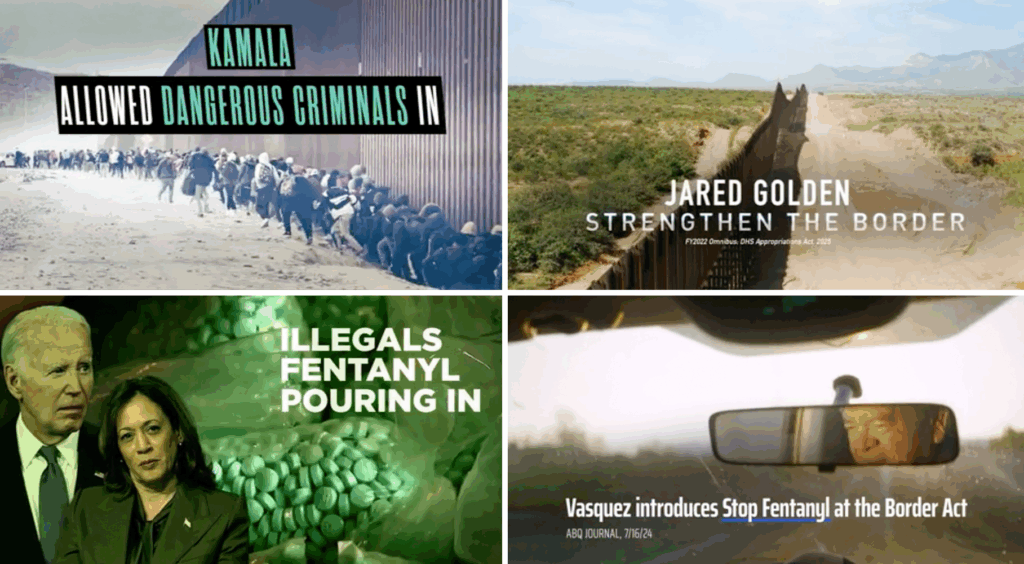The One-Sided Narrative on Immigration and Its Consequences
By Natália de Paula Moreira, Muna Hassan, Yujin Kim, Meiqing Zhang, Breeze Floyd, Erika Franklin Fowler
The passage of the Trump Administration’s so-called “One Big Beautiful Bill” in 2025 directs billions of dollars into immigration enforcement efforts and detention centers, a significant increase over prior funding. The law in many ways follows through on Republican campaign promises made in the 2024 election campaign, when the volume of Republican messaging in campaign advertising about immigration was historically high. A deep dive into the narratives about immigrants and immigration in the 2024 campaign indicates that the messaging from both parties was more negative than in prior cycles. Although campaigns strategically craft political messages in response to public opinion and there is evidence that concern over immigration was rising in 2024, the blitz of negatively framed messaging on the topic may have further contributed to increasing negative views of immigration and immigrants and a permission structure for expansive action, such as the passage of the OBBB. In this analysis, we provide a more in-depth look – using both computational and qualitative analysis – at the discourse surrounding immigration in political advertising in the 2024 election and its potential consequences.
Figure 1: Screenshots from Television Advertising Mentioning Immigration

To identify the main themes in the political ads during the 2024 general election, we first employed a computational technique called BERT-based topic modeling, which analyzes language in an attempt to find patterns for grouping similar text together. (We removed candidate names and geographic locations from this analysis since they would otherwise be prominent words distinguishing specific campaign ads as similar. Spanish ads were not included in the analysis). In addition to immigration, other common topics in the ads included abortion bans, Medicare, social security, drug prices, tax increases, and rising gas prices. The most frequent topics related to immigration portrayed the situation at the southern U.S. border as a national emergency and liberal open-border policies as worsening the issue. Other significant themes included support for conservative fiscal and immigration policies, debates about amnesty for illegal immigrants and government spending on illegal immigrants, and criticism of opponents for ignoring border security and drug crisis.
We then dug in qualitatively to analyze more of the nuanced discussion on immigration, including earlier election cycles. Advertising that touched on immigration in 2024 – no matter the sponsor – almost always conceded that there was a border issue that required a solution. More than that, however, law enforcement and security were prominently featured as the solutions with very little discussion of amnesty for anyone or an acknowledgment of the complexity of ways in which immigrants find their way into the United States. Perhaps in part because of the acceptance of the border framing, there was also vanishingly little language that painted a positive vision of immigration and its benefits to the United States beyond individual acknowledgements in Democratic sponsored Spanish ads of coming from a hard-working immigrant family. This stands in contrast to what we found in earlier election cycles, in which ads featured explicit discussion of immigration as essential to America’s economic strength, the need for compassionate DACA reform, and America being a nation of immigrants where anyone can get ahead.
Although Republican advertising featured immigration more prominently, both parties emphasized negatively valenced messages about immigration. However, their messaging differed in focus and framing.
Republican ads frequently portrayed the border as a crisis caused by Democratic policies, often linking undocumented immigration to violent crimes, trafficking of fentanyl across the border and economic/resource drain. Examples included phrases such as “murdered by illegals” and “Kamala allowed dangerous criminals through our border.” Multiple ads directly tied the fentanyl crisis to border security failures, claiming Democratic policies had allowed cartels and “illegals” to bring drugs into the country (e.g., “Don Davis, Joe Biden, and Kamala Harris have failed us on the border. Woke Democrat policies have illegals and fentanyl pouring in).” Some ads also claimed Democrats supported providing benefits like Medicare and Social Security to undocumented immigrants, arguing this came at the expense of American taxpayers (e.g. “Now Kamala wants struggling seniors to pay more social security taxes, while she gives Medicare and social security to illegals”). Several ads extended this argument to healthcare systems, claiming hospitals were “overwhelmed” by immigrants at the expense of American patients (e.g., “Hospitals everywhere are overwhelmed and American patients are paying the price”). In other words, immigrants were not just dangerous but also a drain on resources.
Figure 2: Screenshots from Pro-Republican Sponsored Television Advertising

Democratic ads, meanwhile, focused on policy solutions, such as hiring more border agents and improving security technology. They frequently cited law enforcement figures, including images or speakers who were sheriffs and Border Patrol agents, to reinforce and toughen their stance on border security. While Democratic ads featured immigration less often than Republican ads and tended to avoid overtly inflammatory language, some of their proposed solutions, such as “deporting violent criminals” and combating the fentanyl crisis – aligned with GOP messaging.
Figure 3: Screenshots from Pro-Democratic Sponsored Television Advertising

As noted earlier, there was a near total absence of positive portrayals of immigrants in campaign ads in 2024. Messages highlighting immigrants’ contributions, such as filling essential jobs, paying taxes, and strengthening communities were virtually non-existent in Republican ads. Spanish-language Democratic ads stood out as an exception, highlighting immigrant contributions through personal narratives, such as stories of immigrant parents working hard to support their families and/or personal stories of immigrant resilience (e.g., “When you’re raised by an immigrant mother, you know what’s possible with determination”). These ads, though few in number, stood in stark contrast to the dominant narrative by emphasizing immigrant perseverance and bipartisan solutions. Nevertheless, the overall discourse remained skewed toward negativity, with little recognition of immigrants’ economic or social contributions.
Political advertising is important, not just because it is a primary vehicle through which candidates for office communicate their policy priorities, but also because it can actively shape the public’s perceptions of important issues and acceptable policy solutions. This detailed analysis of immigration narratives in 2024 suggests that messages surrounding immigration were prominent and dominated by Republicans. When Democrats talked about the issue, their framing of the topic was also negative, leaving the rare Democratic Spanish-language ad to provide any positive perspective. The one-sided narrative on the border as problematic, with security and enforcement as the solutions, likely helped to create the conditions that led to the passage of President Trump’s signature legislation to date that has directed historic increases to immigration authorities for deportation and detention.
Public opinion is not set in stone, and future election cycles may shift the tenor of political conversations about immigrants and immigration policy. For example, evidence from other countries suggests that the success of populist parties in one round of elections might also restore more positive views of immigration. In fact, Gallup’s June 2025 survey already suggests a decrease in concern over immigration and an increasing belief to a historically high level that immigration is a good thing for the United States.
Read more related work from the COMM team:
- What was and wasn’t covered in 2024 campaign advertising
- How political candidates discussed racial and gender identity in 2022 – and what it means for 2024
- On the population health-relevant content of campaign advertising in past presidential elections
- On how exposure to crime in campaign ads can increase worry among Republicans
- On what explains campaign ad attention to social determinants of health
This post was funded by the Robert Wood Johnson Foundation (Grant no. 79754). The views expressed here do not necessarily reflect the views of the foundation.